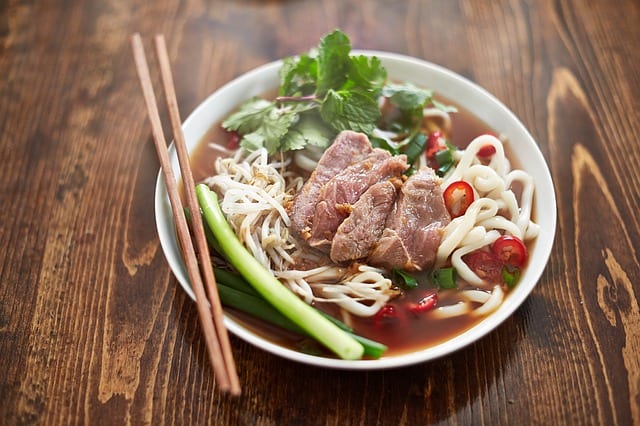
7 Surprising Food Etiquette Rules from Around the World
 You have nailed the basics of elbows off the table, don’t slurp your soup, and don’t talk with your mouth full. You are safe in the knowledge that you can attend a dinner party without committing too many faux pas. However, heading abroad can open up a whole new can of worms. While we appreciate that every country has their own way of doing things when it comes to meal times, a life of continental eating is a tough one to break.
You have nailed the basics of elbows off the table, don’t slurp your soup, and don’t talk with your mouth full. You are safe in the knowledge that you can attend a dinner party without committing too many faux pas. However, heading abroad can open up a whole new can of worms. While we appreciate that every country has their own way of doing things when it comes to meal times, a life of continental eating is a tough one to break.
However, being mindful of traditions and customs of other cultures cannot only help you avoid awkward situations, it can help break the ice with fellow diners. Below are 7 rules belonging to countries from around the world to help you avoid offending the locals.
Capsizing Fishermen in China
Flipping pancakes is standard practice. For those who view the yolk as foe, flipping eggs is also considered passable. But in China, do not flip your fish. In other countries, nobody bats an eyelid if you flip your fish over to devour the other side. You’ve paid for the fish, why not eat it all? However, in southern China and Hong Kong, flipping fish is ‘dao yue’; bad luck. Many diners will often leave the bottom of the fish untouched, or remove the bones to get to the underside. Superstition is the reason for this tradition. It is believed that to flip a fish over is like saying that the fisherman’s boat is going to capsize.
Cutlery Conundrum in Thailand
When new to eating in Thailand, selecting the right implement can feel like dodging bullets. Your eyes dart around the table, feverishly hopping from fork, to spoon, to chopsticks. Then you notice that people are using their hands to eat and panic sets in.
Unlike China and Japan, where chopsticks are the key player, Thailand’s cutlery protocol is a little greyer. Granted, meals hailing from the North and North-Eastern regions are eaten with the hands. For noodle dishes, chopsticks are used.
The real trickery comes when cooked rice is included in a meal. The temptation can be to go wild with the fork and use the refined British technique of ‘shovelling’. However, this is considered rude. Instead, you should use your fork to pack your rice onto the spoon. Food blogger, Leela Punyaratabandhu, states that using chopsticks with a rice meal is the cardinal mistake. “That is awkward and inconvenient at best and tacky at worst,” she says.
Inebriated in Russia
The myth that Russians love vodka is not one to be taken lightly. Russians often laugh that foreigners mix their vodka and sip it slowly. In Russian’s eyes it should be drunk neat, with no ice, as any form of accompaniment is seen as affecting the vodka’s purity.
Anastasia Knezhevich, hailing from Siberia, sells varieties of vodka in her specialist shop. She comments “I keep telling foreigners that you have to drink vodka in one go and exhale through the nose rather than the mouth. That’s why Russians are capable of drinking a lot of vodka and remaining alive afterwards.”
For visitors, this can be difficult. It is considered extremely rude to turn down vodka shots in Russia, as offering a drink is a sign of trust and friendship. So be prepared for Russian hospitality to have you seeing double until you have found out tricks for handling it.
Don’t Ask for Parmesan in Italy
It seems the whole world has a love affair with cheese, but keep your lusting for the delicate shavings of parmigiano-reggiano at bay in Italy. Tainting pizza or pasta in Italy with parmesan is the equivalent of asking for ice in your wine. Many dishes in Italy simply aren’t meant to be laden with parmesan. As a rule, if you are not offered parmesan, do not ask for it.
Belly Busting in Brazil
Brazilian steakhouses, known as churrascarias, are famous for their cuts of meat. Servers circle the restaurant with platters bequeathed with some of the tastiest Brazilian barbeque and diners use tokens to place an order. Tokens are two sided; one green and one red. It is important to remember that if you would like the option on offer, have the token showing green. If you are full or don’t fancy the food, make sure your token is showing red. The meat can be never-ending in these steakhouses, and you could end up triple parked with ribs, with a steak on the way, if you forget to show the red side. It is all about strategy and token technique in churrascarias.
Caffeine Overload in the Middle East
For Bedouins coffee is a way of life. During holidays like Eid, weddings, and periods of mourning, coffee is served frequently. For Bedouins, coffee is more than just a drink, it is an important symbol of hospitality and trust. Bedouins serve small amounts of coffee in small cups with no handle. Often, they will serve three cups. The first cup is for the soul. The second is for the sword. The third is because you are a guest. If you are not a coffee lover, simply grin and bear it. However, after your third cup, do not be surprised if your host continues to refill your cup the entire time. To show your Bedouin host you do not require any more coffee, shake or tilt the cup before handing it back to your host.
Funeral Chopsticks in Japan
Mastering chopsticks is a task in itself, let alone having to consider their table-top positioning. Whilst enjoying Japanese cuisine, ensure your chopsticks are placed together right in front of you, parallel to the table edge. Even better, if there is a chopstick rest, use it. No matter how tempting, like sticking a flag in a sandcastle, do not plant your chopsticks upright in a rice dish. During funerals in Japan, the favourite rice bowl of the deceased is placed in their coffin, with their chopsticks upright in the rice. Many Japanese people argue that this act is worse than asking for a fork, which was originally considered the ultimate dining sin.
